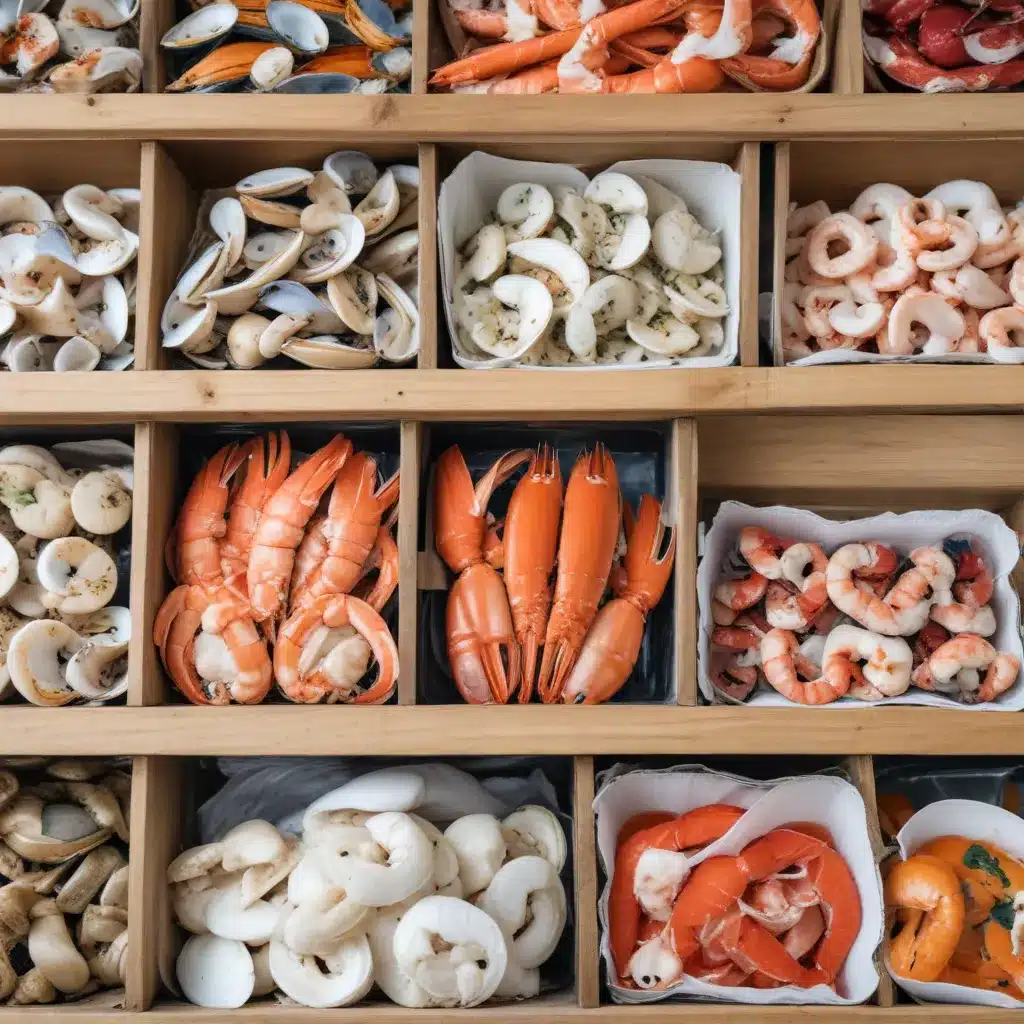
As a seafood dining expert for Fish Tales Cafe, I’m excited to share my insights on the art of seafood storage. Proper handling and preservation of these delicate ingredients is crucial for unlocking their full flavor potential and ensuring food safety. Whether you’re a home cook exploring the wonders of cod, or a professional chef managing a diverse seafood inventory, understanding the principles of seafood storage can be a game-changer.
Seafood Preservation Principles
At the heart of seafood storage is the imperative to maintain the freshness and quality of your ingredients. Finfish, shellfish, and other marine delicacies are highly perishable, requiring vigilant attention to temperature, humidity, and handling techniques. The key is to minimize exposure to factors that can accelerate spoilage, such as fluctuating temperatures, excessive moisture, and prolonged air exposure.
Proper Refrigeration Techniques
When it comes to refrigerated storage, the golden rule is to maintain a consistent temperature between 32°F and 40°F. This “danger zone” range is the sweet spot for inhibiting the growth of harmful bacteria while preserving the seafood’s natural texture and flavor. Investing in a high-quality, well-calibrated refrigerator is a must, as even minor temperature variations can significantly impact shelf life.
Freezing for Extended Shelf Life
For longer-term storage, freezing is a reliable option that can extend the lifespan of your seafood by several months. The key is to utilize proper freezing techniques, such as blast freezing or cryogenic freezing, which rapidly lower the temperature to preserve the seafood’s structure and prevent the formation of large ice crystals. Proper packaging, such as vacuum sealing or modified atmosphere packaging, is also essential to prevent freezer burn and lock in freshness.
Optimal Storage Conditions
Beyond temperature control, maintaining the right humidity levels is crucial for seafood storage. Optimal humidity ranges from 85% to 95%, as excess moisture can lead to microbial growth and spoilage, while overly dry conditions can cause the seafood to dehydrate and lose its delicate texture.
Packaging and Labeling Strategies
Effective packaging is a cornerstone of seafood storage. Airtight, leak-proof containers, vacuum-sealed pouches, or modified atmosphere packages are all viable options that can shield seafood from airborne contaminants and prevent cross-contamination. Proper labeling, including the seafood type, catch date, and expiration date, is essential for maintaining traceability and ensuring food safety.
Seafood-Specific Storage Guidelines
Each type of seafood has its own unique storage requirements. Finfish, such as cod, benefit from being stored on ice or in a brine solution to maintain their moisture and firmness. Shellfish, on the other hand, require specialized handling to prevent the growth of harmful bacteria. Delicate seafood, like sashimi or ceviche, demand even more meticulous attention to temperature and handling to preserve their delicate textures and flavors.
Maximizing Freshness and Quality
Monitoring the condition of your seafood is crucial for ensuring optimal freshness and quality. Familiarize yourself with the visual, olfactory, and tactile cues that indicate freshness, such as the sheen of the flesh, the brightness of the eyes, and the absence of any off-putting odors. Regularly inspecting your seafood inventory and promptly addressing any signs of spoilage can significantly extend its shelf life.
Seafood Freezing Fundamentals
When it comes to freezing seafood, proper techniques and thawing procedures are essential for preserving quality and texture. Utilize rapid freezing methods, such as blast freezing or cryogenic freezing, to minimize the formation of large ice crystals that can compromise the seafood’s structure. Thawing should be done gradually, either in the refrigerator or under cool running water, to prevent the seafood from becoming waterlogged or losing its delicate texture.
Specialized Storage Solutions
Innovative storage technologies, such as modified atmosphere packaging and vacuum sealing, can further enhance the preservation of seafood. These methods reduce oxygen exposure and inhibit the growth of aerobic bacteria, allowing for extended refrigerated or frozen shelf life. Additionally, emerging chilling technologies, like sous vide or cryogenic freezing, offer enhanced control over temperature and humidity, elevating the quality and safety of stored seafood.
Seafood Safety and Traceability
Maintaining the integrity of the cold chain is paramount for ensuring seafood safety. Proper handling techniques, including the use of sanitized equipment and adherence to recommended storage temperatures, are crucial for preventing cross-contamination and the growth of harmful pathogens. Comprehensive labeling and record-keeping also play a vital role in seafood traceability, allowing for the rapid identification and isolation of any potentially compromised products.
Sustainable Seafood Storage Practices
As we strive to minimize food waste and promote sustainability, seafood storage presents an opportunity to make a meaningful impact. Optimizing storage methods to extend the shelf life of your seafood inventory can significantly reduce the environmental footprint associated with discarded products. By embracing innovative preservation techniques and fostering a culture of responsible seafood handling, we can contribute to a more sustainable seafood ecosystem.
Mastering the art of seafood storage is a journey of discovery, but the rewards are plentiful. From unlocking the natural flavors of cod to ensuring the safety and quality of your seafood inventory, a deep understanding of storage principles can be a game-changer for seafood enthusiasts and professionals alike. By investing in the right tools, techniques, and knowledge, you can elevate your seafood dining experience and contribute to a more sustainable food system. Explore the wonders of seafood storage with Fish Tales Cafe and unlock the key to maximizing shelf life.

